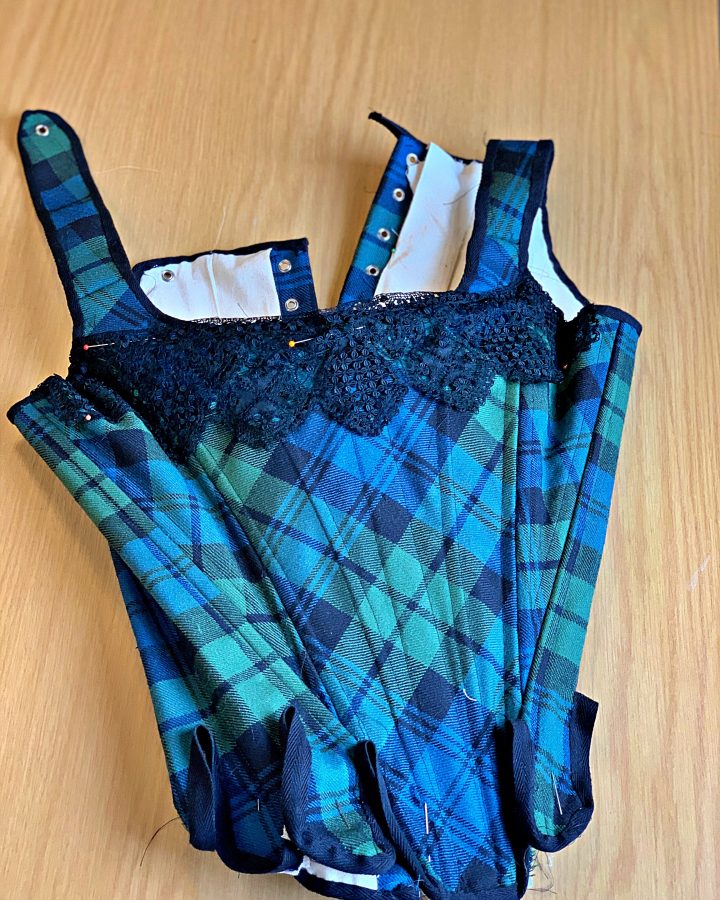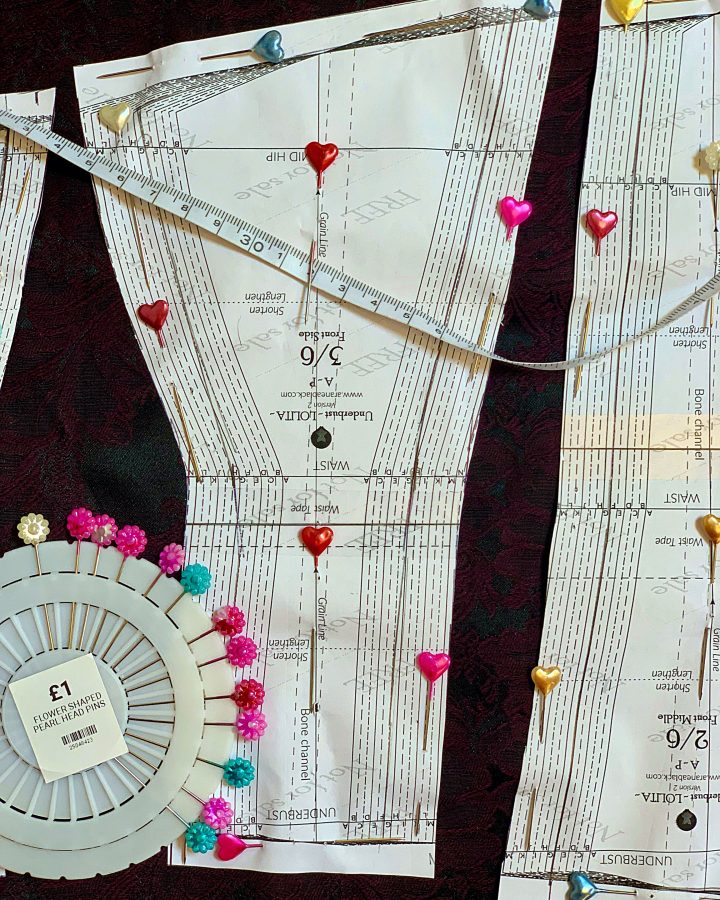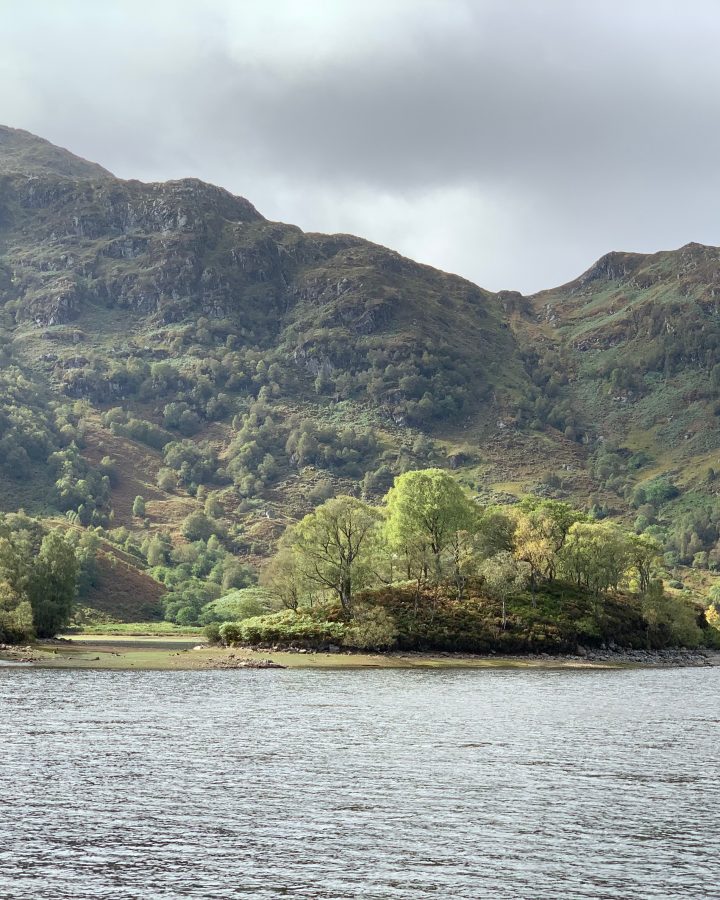Gartmore House near Stirling in Scotland is a charity that hosts residential courses with full board. The classes range from watercolours (the countryside is stunning), to patchwork quilting, willow work or outdoor activities such as hill walking.
I chose to learn how to make a corset or more accurately, a ‘stay’, the precursor to corsets (which are the precursor to the bra.)There are two types of stay: full boned and half-boned, we are making the latter. Stays were in use between Tudor times and the end of the 18th century. In Tudor times they were longer and more conical, with farthingales underneath but became curvier in the 18th century with a lower waist, under which a bum roll and pockets are added. The character of Claire in Outlander wears stays.
“The great thing about making corsets is that you don’t need huge tables for cutting them out” said our tutor Alison Campbell (@crikeyaphrodite on instagram), by day a Bravissimo fitter, who can eyeball a cup-size at a 100 paces.
I’m far from a standard size, so her help and skill in adjusting the historical pattern by J.P. Ryan to my petite plus size shape was invaluable. There are 7 pieces to a stay and they are fitted together in a counter-intuitive way. This work is more akin to architecture and engineering (after all Howard Hughes designed a bra for Jane Russell’s tremendous curves) than dressmaking.
“Traditionally corset-makers were men as you need strong fingers to do the boning and to whip panels together with twine”.
Historically stays were made of layers of densely woven linen and a couple of layers of rag paper (like watercolour paper). There is a thick ‘bone’ down the front, called a ‘busk’, made of wood. These were often carved and decorated gifts from lovers, as they are near the heart. The stays were never washed, but worn with a chemise underneath. Everybody wore them, even though they were expensive to get made, young, old, rich, poor. It was considered to be slightly obscene not to wear them, like going without a bra. The phrase ‘loose women’ derived from the uncorseted.
Today we use different materials: the four layers are calico, cotillon (a stiff thick fabric), a second layer of calico and finally the decorative top fabric. In the past baleen was used to bone the stay, which are the small bones from inside a whale’s mouth. Today the equivalent is ‘German Plastic’.
The prudishness of Victorian times was not applicable to the 18th century: women would use chamberpots under their skirts to piss in at social events. There is a course next spring to make a Victorian corset, a more waist-clinching affair with steel bones.
Today the most famous corset-maker is Mr Pearl who has worked for haute-couture designers such as Galliano, McQueen, Westwood, Mugler. He makes the corsets for Dita Von Teese, the burlesque star. Rumour has it that Daniel Day-Lewis based his quiet yet finicky lead role in ‘Phantom Thread’ on Mr Pearl.
Alison has some transwomen as clients who use corsets to mould a womanly shape : “for them it’s all about the distance between the bottom of the ribs and the top of the pelvis-there isn’t as much space”.
Of her experience at Bravissimo, Alison said that the ‘standard’ B cup is a rarity. We looked at photographs of actresses Barbara Windsor and Jayne Mansfield. Neither actually had large breasts but had flaring ribs which made the contrast between their bust and the narrow waist more obvious.
Gartmore House itself, built in 1793, with later additions in the Arts and Crafts style, is an oak-panelled manor with grand staircases painted white, so that the interior resembles a vintage wedding cake. The Labour Party co-founder Cunninghame Graham who later also founded The Scottish National Party, lived here for many years. During the Second World War, the building was commandeered by the army, in the 1950s it was a borstal for naughty boys.
The house is situated in an area known as the Trossachs around Loch Lomond where Scotland divides into Lowland and Highlands. The Highlanders are descendants of the Picts (wee, tough, strong, resilient), spoke Gaelic while Lowlanders are Scots, speak Scots rather than Gaelic (which some say makes a nonsense of the SNP’s bilingual Gaelic/English road signs).
In the middle of the course, the class went for a day trip to Loch Katrine. The autumnal colours, coral trees, rowan fruit, rusty ferns, bright red tug boats and glittering waters were a fantastic breather between days of staring at stitching. My fingers were bleeding from pin pricks by the end: ‘little sacrifices to the gods of sewing’ suggested Alison.
Tourism had a great boom in Scotland during the Victorian era: Sir Walter Scott’s romanticised portrait of highlander life attracted Queen Victoria and English tourists. (The Victorian era was a backlash to the terrible oppression of highland culture during the 18th century as depicted in Outlander where tartans were banned after the Battle of Culloden).

In 2022, a 5 night break including tuition, most materials and full board (breakfast, elevenses, lunch, tea and supper) in a double room/two singles costs £979 per person. https://www.gartmorehouse.com




















Loved that trip to Scotland